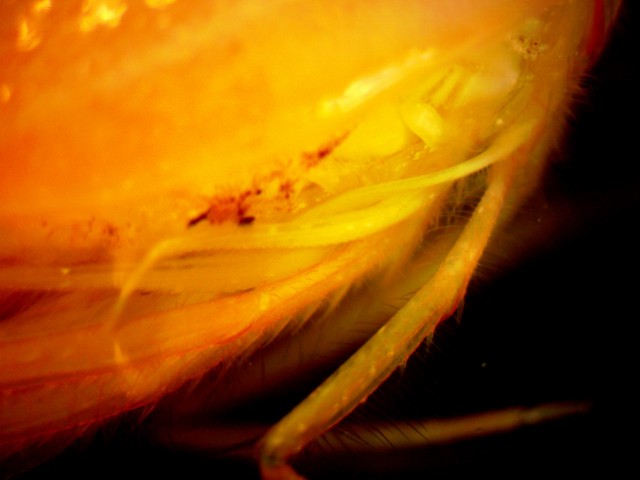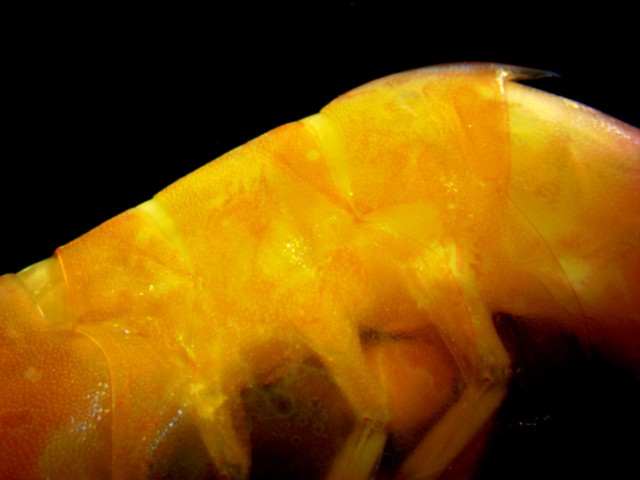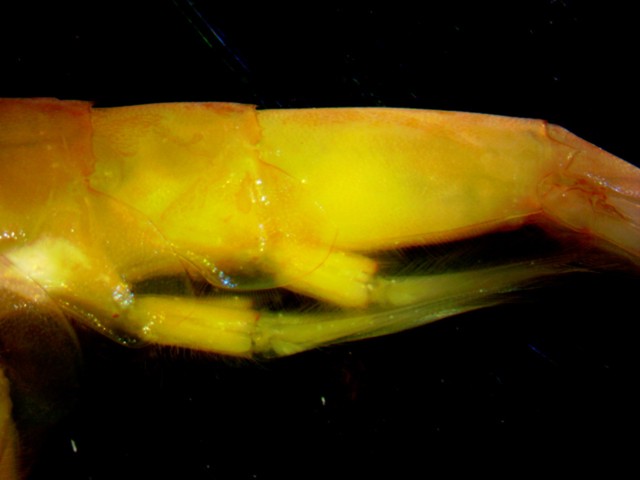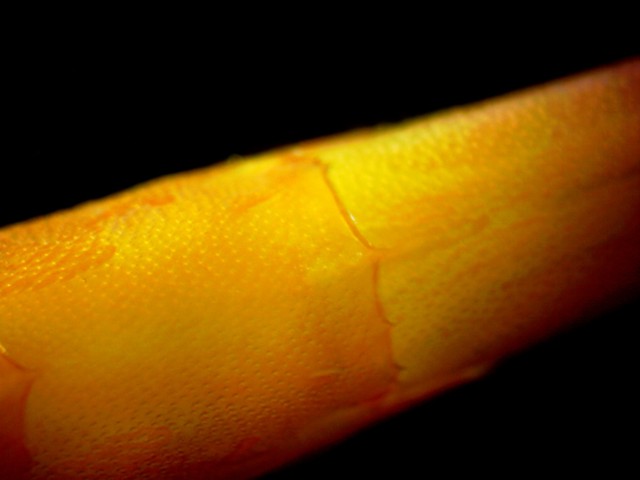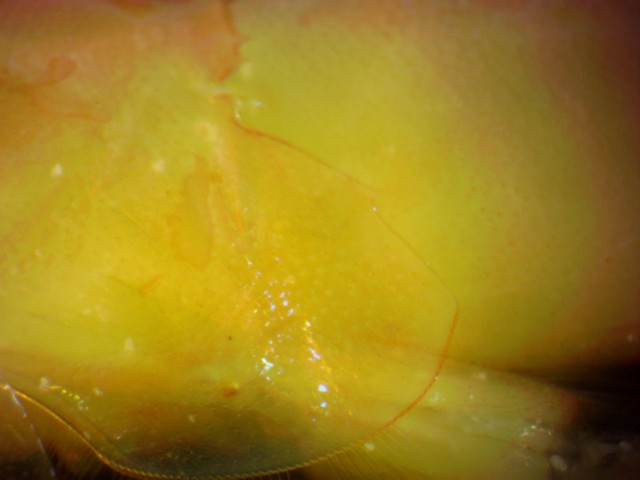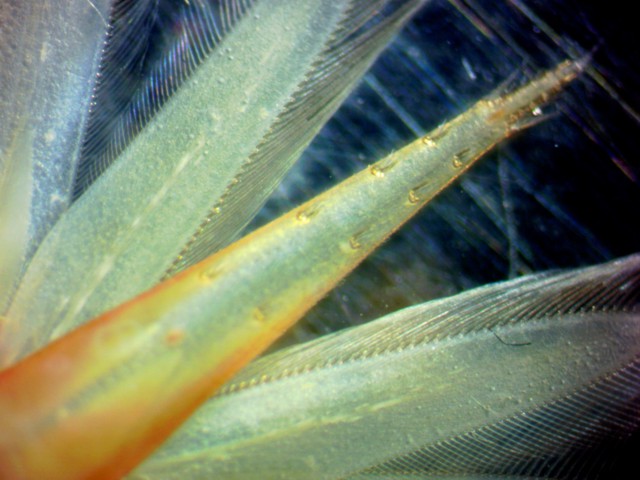Systellaspis debilis (A. Milne Edwards)Common name(s): Fewspine spinytail |
|
| Synonyms: Acanthephyra debilis | 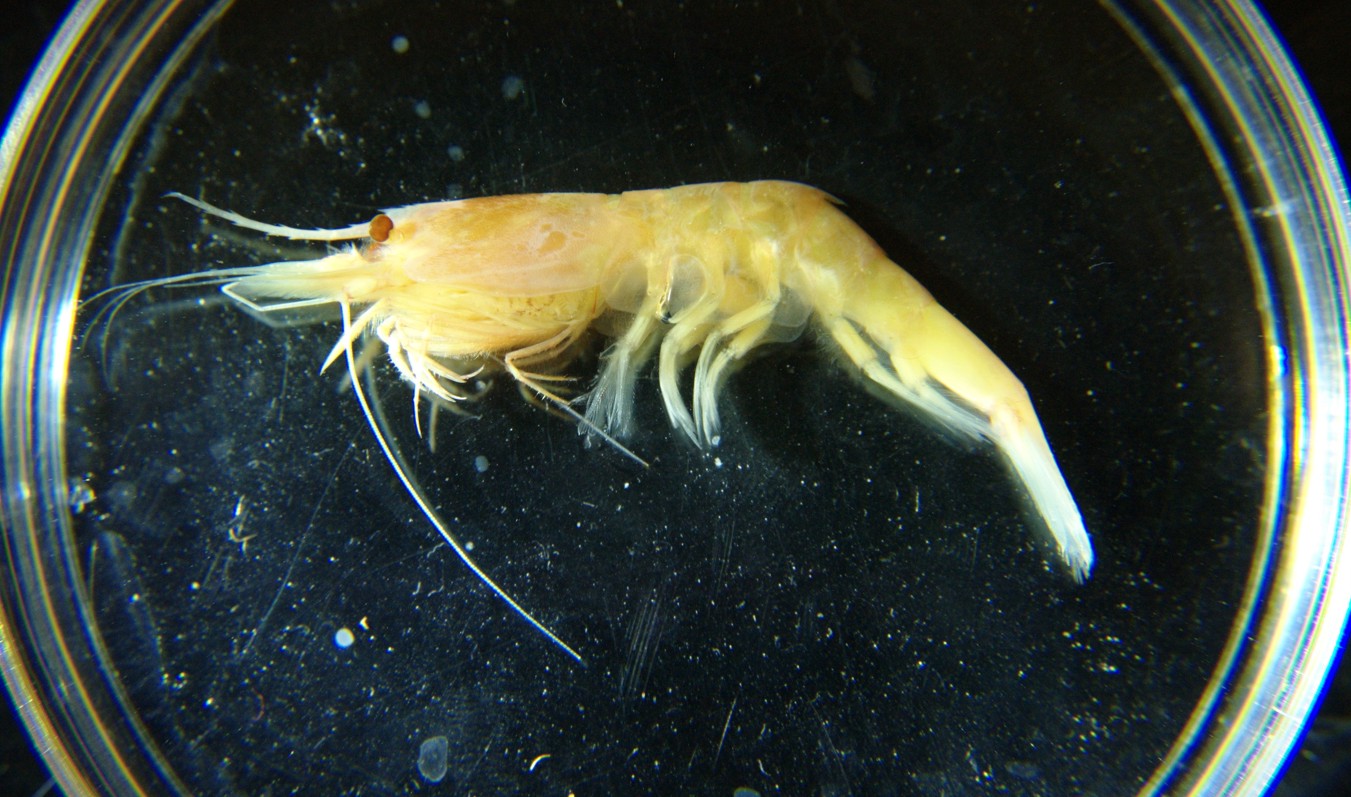 |
|
Phylum Arthropoda
Subphylum Crustacea
Class Malacostraca
Subclass Eumalacostraca
Superorder Eucarida
Order Decapoda
Suborder Pleocyemata
Infraorder Caridea
(true shrimp)
|
|
| Systellaspis debilis, preserved specimen captured in midwater off Oahu, Hawaii in 1996. Compare petri dish for size. In life the shrimp would be bright red. | |
| (Photo by: Dave Cowles) | |
Description: This is a true shrimp from the family Oplophoridae, which lives in deep midwater offshore. True (Caridean) shrimp such as these have the second abdominal epimera (pleuron) overlapping that of segment 1 and 2. Family Oplophoridae is almost entirely midwater, has exopodites on its pereopods (photo), and pereopods 1 and 2 are longer and more stout than the others. Systellaspis have a well-developed rostrum, no horizontal carina on the carapace, and no dorsal ridge on the sixth abdominal segment (photo). The telson ends in a sharp point, with spines on the sides. Their eyes are well pigmented, and their eggs are large and few (each female may carry less than 50). Systellaspis debilis has a long rostrum (much longer than the antennal scale) with 14 dorsal and 9 ventral teeth and a pointed tip. The exopods of its third maxilliped and of all pereopods are about the same length (photo). The epipod on pereopod 4 is well-developed except for the vertical component (photo). Pereopods 1 and 2 are chelate, 3-4 have simple dactyls, and the dactyl on pereopod 5 is paddle-like. The carapace is not carinate (ridged) on the posterior half of the dorsal midline and has no sinuous lateral ridge extending posteriorly from the orbital region (near the eye) to nearly the posterior margin. The second abdominal segment has no posterior dorsal spine (photo). The appendix masculina on the second pleopod of males is much longer than is the appendix interna. The third abdominal segment has a blunt dorsal carina (ridge) which ends in a large posterior dorsal spine (photo). The fourth and fifth abdominal segments have a posterior dorsal spine which has small spines lateral to it (photo photo). The fifth abdominal segment has a spine on the posterior margin of the pleuron (photo). The sixth abdominal segment is dorsally rounded (photo) and about 1 2/3 as long as the fifth (photo). The telson has a shallow sulcus (groove) down the dorsal midline, a spiny endpiece flanked by a pair of long spines, plus a lateral row of 4-8 (not more than 10) spines on each side (photo). Living individuals are strong red or scarlet, with lighter red or orange on some appendages. Carapace length to 1.7 cm.
How to Distinguish from Similar Species:Systellaspis braueri and S. cristata have dorsolateral rows of at least 20 spines on each side of the telson, plus have a sinuous lateral ridge which extends posteriorly on the carapace from the orbital region to nearly the posterior carapace margin.
Geographical Range: Worldwide in most tropical or warm-temperate seas: Pacific, Indian, Atlantic, Gulf of Mexico, Caribbean Sea. Along our coast it is found off California and Oregon.
Depth Range: 0-1500 m; mainly at 650-800 m in daytime and around 150 m at night.
Habitat: Mesopelagic, especially below tropical to warm temperate waters
Biology/Natural History:
This is
a very common mesopelagic shrimp which vertically migrates
daily.
It may release a bioluminescent cloud when disturbed.
| Return to: | |||
| Main Page | Alphabetic Index | Systematic Index | Glossary |
References:
Dichotomous Keys:Wicksten, 2009
General References:
Chace,
Fenner A., 1986. The caridean shrimps (Crustacea:
Decapoda) of
the Albatross Philippine expedition, 1907-1910, Part 4: Families
Oplophoridae
and Nematocarcinidae. Smithsonian Contributions to Zoology
432
Cowles, David L., 1988. Factors affecting the aerobic matabolism of midwater crustaceans. Ph.D. dissertation, University of California, Santa Barbara. 228 pp.
Cowles, D.L., J.J. Childress, and M.E. Wells, 1991. Metabolic rates of midwater crustaceans as a function of depth of occurrence off the Hawaiian Islands: food availability as a selective factor? Marine Biology 110: pp 75-83
Frank, T.M, and E.A. Widder, 1994. Evidence for behavioral sensitivity to near-UV light in deep-sea crustacean Systellaspis debilis. Marine Biology 118: pp. 279-284
Gaten, Edward, and Peter J. Herring, 2005. Morphology of the reflecting superposition eyes of larval oplophorid shrimps. Journal of Morphology 225:1 pp 19-29
Gaten, E., P.M.J. Shelton, and P.J. Herring, 1992. Regional morphological variations in the compound eyes of certain mesopelagic shrimps in relation to their habitat. Journal of the Marine Biological Association of the United Kingdom 72: Issue 01 pp 61-75
Napora, T.A., 1964. The effect of hydrostatic pressure on the prawn, Systellaspis debilis. Occasional Publication 2, School of Oceanography, University of Rhode Island pp. 92-94.
Nowel, M.S., P.M.J. Shelton, and P.J. Herring, 1998. Cuticular photophores of two decapod crustaceans, Oplophorus spinosus and Systellaspis debilis. Biological Bulletin 195: pp 290-307
Roe, H.S.J., 1984. The diel migrations and distributions within a mesopelagic community in the north east Atlantic. 2. Vertical migrations and feeding of mysids and decapod crustacea. Progress in Oceanography 13: pp. 269-318
Thomson, C.M., P.J. Herring, and A.K. Campbell, 1995. Evidence for De Novo biosynthesis of coelenterazine in the bioluminescent midwater shrimp, Systellaspis debilis. Journal of the Marine Biological Association of the U.K. 75: pp 165-171
Scientific Articles:
Web sites:
General Notes and Observations: Locations, abundances, unusual behaviors:
The following photos are of a preserved specimen collected in
midwater
off Oahu, Hawaii in 1996.
This photograph of the left side of the shrimp shows pereopods 3-5 (#5 is to the right). The endopods are robust and have reddish setae. The ventral edge of the carapace is visible at the top of the photo. The epipod on pereopod 4 can be seen must below the edge of the carapace, branching from the coxa. The exopods, which look like long flexible yellowish extensions, can be seen on pereopods 3-5, branching from the basis. Note that the exopods are of similar length to each other.
A side view of abdominal segments 1-3. Note that segment 2 has no posterior dorsal spine, while segment 3 is dorsally carinate and ends with a long medial dorsal spine. This view is of the left side of the shrimp, anterior is to the left.
A side view of abdominal segments 4-6 (4 is to the left). Note the small posterior medial dorsal spines on segments 4,5 and the small spines lateral to them. Note also the tooth on the posterior margin of the pleuron of segment 5. Anterior is to the left.
This dorsal view of abdominal segments 5-6 shows the small posterior medial dorsal spine on segment 5 and the small spines lateral to it. Anterior is to the left.
This lateral closeup view of abdominal pleuron 5 shows the sharp tooth along the posterior margin. Anterior is to the left.
This dorsal view of abdominal segment 6 shows that it rounded and has no dorsal carina (ridge). Anterior is to the left and the base of the uropods and telson are on the upper right.
This dorsal view of the pleopods and telson
show that the telson
has a shallow dorsal groove (sulcus).
It also has a spiny endpiece flanked by two spines, and two
dorsolateral
rows of 4-8 spines.
Authors and Editors of Page:
Dave Cowles (2012): Created original page
CSS coding for page developed by Jonathan Cowles (2007)
Salish Sea Invertebrates web site provided courtesy of Walla Walla University
